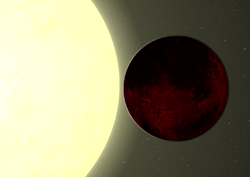Kepler-78
Kepler-78 (formerly known as KIC 8435766) is a 12th magnitude star in the constellation Cygnus.[2] This star has a radius of about 74% of the Sun, and a temperature of about 5100 K.
 Artist's impression of the planet Kepler-78b around Kepler-78 | |
| Observation data Epoch J2000 Equinox J2000 | |
|---|---|
| Constellation | Cygnus |
| Right ascension | 19h 34m 58.0143s[1] |
| Declination | +44° 26′ 53.961″[1] |
| Apparent magnitude (V) | 11.72[2] |
| Characteristics | |
| Spectral type | late G[3] |
| Astrometry | |
| Proper motion (μ) | RA: 37.807±0.973[1] mas/yr Dec.: −16.348±0.696[1] mas/yr |
| Parallax (π) | 8.02 ± 0.25[1] mas |
| Distance | 410 ± 10 ly (125 ± 4 pc) |
| Details[4] | |
| Mass | 0.81±0.05 M☉ |
| Radius | 0.74+0.1 −0.08 R☉ |
| Temperature | 5089±50 K |
| Metallicity [Fe/H] | −0.14±0.08 dex |
| Other designations | |
| Database references | |
| SIMBAD | data |
| KIC | data |
Planetary system
Kepler-78 planetary system is composed by one planet called Kepler-78b, a planet slightly bigger than Earth with an extremely close orbit to the parent star. The orbital period of this planet is about 8.5 hours because of its proximity to its star. While it has a similar density to the Earth (at 5.57 g/cm3, its surface temperature is about 1300 to 1500 K.[5]
| Companion (in order from star) |
Mass | Semimajor axis (AU) |
Orbital period (days) |
Eccentricity | Inclination | Radius |
|---|---|---|---|---|---|---|
| b | 1.86+0.38 −0.25 M⊕ |
0.0089 | 0.3550 ± 0.0004 | 0 | 79+9 −14° |
1.173+0.0159 −0.089 R⊕ |
gollark: How do you enforce money actually going to the company or whatever address (I assume you have those)?
gollark: Why does it need a giant building?
gollark: Wasn't it meant to be a shares system or something?
gollark: <@184468521042968577> What's the KTC actually før?
gollark: I quite like the pacman argument style myself.
References
- Brown, A. G. A; et al. (2016). "Gaia Data Release 1. Summary of the astrometric, photometric, and survey properties". Astronomy and Astrophysics. 595. A2. arXiv:1609.04172. Bibcode:2016A&A...595A...2G. doi:10.1051/0004-6361/201629512.Gaia Data Release 1 catalog entry
- "Kepler-78". SIMBAD. Centre de données astronomiques de Strasbourg.
- Sanchis-Ojeda, Roberto; et al. (2013). "Transits and Occultations of an Earth-sized Planet in an 8.5 hr Orbit". The Astrophysical Journal. 774 (1). 54. arXiv:1305.4180. Bibcode:2013ApJ...774...54S. doi:10.1088/0004-637X/774/1/54.
- "Notes on Kepler-78 b". Retrieved 9 January 2017.
- Pepe, Francesco; Cameron, Andrew Collier; Latham, David W.; Molinari, Emilio; Udry, Stéphane; Bonomo, Aldo S.; Buchhave, Lars A.; Charbonneau, David; Cosentino, Rosario; Dressing, Courtney D.; Dumusque, Xavier; Figueira, Pedro; Fiorenzano, Aldo F. M.; Gettel, Sara; Harutyunyan, Avet; Haywood, Raphaëlle D.; Horne, Keith; Lopez-Morales, Mercedes; Lovis, Christophe; Malavolta, Luca; Mayor, Michel; Micela, Giusi; Motalebi, Fatemeh; Nascimbeni, Valerio; Phillips, David; Piotto, Giampaolo; Pollacco, Don; Queloz, Didier; Rice, Ken; et al. (2013). "An Earth-sized planet with an Earth-like density". Nature. 503 (7476): 377–80. arXiv:1310.7987. Bibcode:2013Natur.503..377P. doi:10.1038/nature12768. PMID 24172902.
This article is issued from Wikipedia. The text is licensed under Creative Commons - Attribution - Sharealike. Additional terms may apply for the media files.